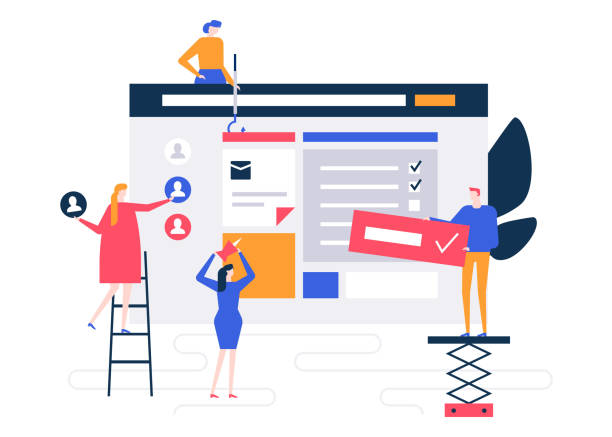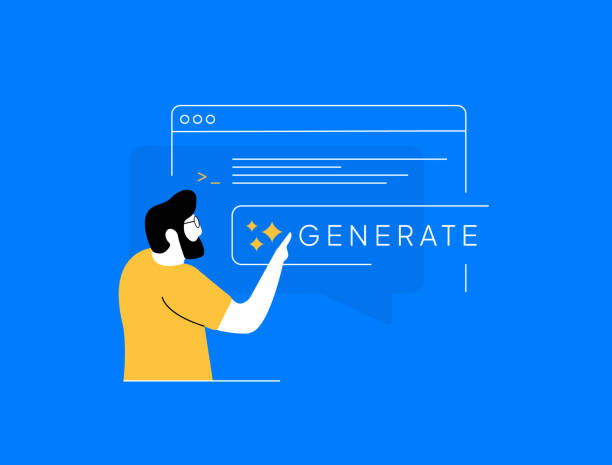Introduction to the Importance of Professional Website Design

In today’s digital world, having a strong online presence is more vital than ever.
A website is the virtual storefront of your business and will be the first point of contact for many customers with your brand.
Therefore, the importance of #professional_website_design cannot be overlooked. This is not just about having a beautiful site; rather, it encompasses creating a flawless user experience, attracting visitors, and converting them into customers.
Imagine having a website that effectively meets user needs, loads quickly, and presents necessary information clearly and accessibly.
Such a website not only enhances your credibility but also gains audience trust and encourages them to stay and explore further.
A #standard and professional #website is a powerful tool for #branding, marketing, and selling your products or services.
In fact, many customer purchasing decisions are made based on their first impression of your website.
If your website appears outdated, slow, or unreliable, you will quickly lose potential customers.
In contrast, a professional website design that is modern and user-friendly demonstrates your commitment to quality and attention to detail.
This holds true not only for large corporations but also for small businesses and startups; a strong online presence can be a bridge to new markets and countless opportunities.
Investing in professional website design and development means investing in the future of your business, as it provides the main platform for digital communications and online transactions.
This platform must also be capable of supporting your business’s future growth and development.
This educational and comprehensive article helps you familiarize yourself with the key principles and factors in web design.
From platform selection to search engine optimization (SEO), we will cover all aspects.
The goal is to provide you with precise and practical guidance so you can make the best decisions for your professional website design project.
Remember that your website is a valuable asset, and with proper investment in its design and development, you can achieve significant returns.
This process requires specialized knowledge and a deep understanding of audience needs.
To achieve business goals and create an exceptional user experience, an analytical approach to user behavior and feedback is essential.
In this article, we will also address thought-provoking content that may present new challenges on your professional website design journey.
Join us as we proceed step by step on this exciting path.
Is your current e-commerce website design not generating the sales you expect?
RasaWeb specializes in professional e-commerce website design!
✅ An attractive and user-friendly site aimed at increasing sales
✅ High speed and security for an ideal shopping experience⚡ Get a free online store design consultation with RasaWeb!
Key Principles in Professional Website Design and User Experience (UX)

After understanding the importance of professional website design, it’s time to address the key principles that form the foundation of a successful website.
User Experience (UX) and User Interface (UI) are two main pillars that directly impact visitor satisfaction and conversion rates.
A website with strong UX makes the user’s interaction process with the site simple, enjoyable, and efficient.
This includes easy and logical navigation, fast page loading times, and Responsive Design that displays the website well on any device, from mobile to desktop.
Responsive design not only improves user experience but is also crucial for SEO, as search engines prefer mobile-friendly sites.
Intuitive navigation is one of the most important aspects; users should be able to easily find the information they need without confusion.
The menu structure should be clear and hierarchical, using terms understandable to the audience.
Furthermore, attractive visual design (UI) also plays a significant role.
Color schemes, fonts, images, and videos should all align with your brand’s visual identity, creating a pleasant and professional atmosphere.
Appropriate use of white space, visual balance, and adherence to Gestalt principles can help better organize content and reduce visual clutter.
These aspects are taught in educational and specialized professional website design courses.
Another important principle is a clear Call to Action (CTA).
Each page should have a specific goal and guide users towards performing a particular action (such as purchase, registration, or contact).
These CTAs should be clearly visible and have compelling text.
Additionally, website Accessibility for all users, including those with disabilities, is very important.
Adhering to WCAG standards helps you have an inclusive website.
Finally, continuous feedback from users and analysis of their behavior are essential for continuous improvement of the user experience.
This analytical and iterative process allows you to identify weaknesses and address them, achieving a truly professional website design that benefits both your business and your users.
These guidelines are the key to your website’s success.
Choosing the Right Platform and Necessary Tools

Choosing the right platform for professional website design is one of the most important decisions you need to make at the outset.
This choice depends on your specific business needs, budget, technical skills, and long-term goals.
There are two main approaches to building a website: using Content Management Systems (CMS) like WordPress, Joomla, and Drupal, or custom coding using languages like HTML, CSS, JavaScript, PHP, Python, and related frameworks.
Each of these options has its specific advantages and disadvantages that must be carefully considered.
Content Management Systems (CMS) are ideal for many users, especially those with little coding knowledge or who want to launch their website quickly, due to their ease of use and high flexibility.
WordPress alone supports over 40% of the world’s websites and, with its vast ecosystem of plugins and themes, provides countless possibilities for creating any type of website, from personal blogs to large online stores.
Joomla and Drupal are also powerful options, but they are typically used for more complex projects with more specialized needs.
These platforms present their features in an explanatory manner.
In contrast, custom coding gives you complete control over every aspect of the website and is ideal for projects with highly unique needs and high performance.
This method requires more expertise in programming and design and typically takes more time and costs more.
However, the final results can be significantly more optimized and scalable.
Tools required for this approach include code editors (like VS Code), version control (Git), and web development tools like Node.js or Python.
Choosing the right platform can significantly impact the success and efficiency of your professional website development project and ensure its future.
Below, a comparative table of the most popular CMSs is provided to help you make a decision.
| Feature | WordPress | Joomla | Drupal |
|---|---|---|---|
| Ease of Use | Very High | Medium | Low (requires technical knowledge) |
| Flexibility | High (with plugins) | High | Very High |
| Security | Medium (can be increased with plugins) | High | Very High |
| Development Cost | Low to Medium | Medium | Medium to High |
| Support Community | Very Large | Medium | Large |
The Importance of SEO and Search Engine Optimization

After laying the groundwork for your professional website design, the next crucial step is optimizing it for search engines, or SEO.
Without SEO, even if you have the most beautiful and user-friendly website, it might not be seen.
SEO refers to a set of techniques and strategies aimed at increasing your website’s ranking in the organic (non-paid) search results of search engines like Google, Bing, and Yahoo.
This means attracting more targeted traffic to your website, ultimately leading to increased customers and sales.
SEO has three main pillars: On-Page SEO, Off-Page SEO, and Technical SEO.
On-Page SEO involves optimizing content and HTML elements within your website, such as using appropriate keywords in titles, meta descriptions, headings, and body text, optimizing images, and URL structure.
This section requires a precise analytical approach to keyword selection and understanding user search intent.
Off-Page SEO refers to activities outside your website that help improve its ranking, such as link building (quality backlinks from reputable sites), social media marketing, and online branding.
Technical SEO also involves optimizing the technical structure of the website for better crawling and indexing by search engines.
This includes site loading speed, mobile compatibility, using an SSL certificate (HTTPS), sitemap structure, and the robots.txt file.
The more technically optimized your website is, the easier search engines can understand its content and display it to users.
Engaging and high-quality content plays a key role in SEO success, as Google aims to provide the best answers to its users.
Providing comprehensive guidance and complete explanations about your products or services can significantly help attract organic traffic.
Therefore, every professional website design project should start with SEO principles in mind to ensure maximum visibility.
Does your company’s website create a professional and lasting first impression in the minds of potential customers? RasaWeb, with its professional corporate website design, not only represents your brand’s credibility but also opens a path for your business growth.
✅ Creating a powerful and trustworthy brand image
✅ Attracting target customers and increasing sales
⚡ Get a free consultation
Content is King: Content Production Strategy

In the digital world, the phrase “Content is King” proves its truth more than ever.
High-quality, engaging, and valuable content not only attracts users but also encourages them to stay on your website and interact with it.
A content production strategy is an inseparable part of professional website design and online success.
Content can appear in various forms such as blog articles, videos, infographics, podcasts, guides, and product descriptions.
The main goal of content should be to provide value to the audience and address their needs and questions.
To develop an effective content strategy, you must first accurately identify your target audience.
Understanding their needs, interests, and challenges helps you produce content that is truly beneficial to them.
Then, conduct keyword research to understand what terms your audience uses to search for information.
These keywords should be naturally integrated into your content to increase visibility in search engines.
Diversity in content format is also important; some users prefer to read text articles, while others are more interested in visual or video content.
Creating entertaining content alongside educational material can significantly boost user engagement.
Furthermore, regular content publishing planning and a content calendar are of high importance.
Websites that consistently publish fresh and relevant content not only perform better in terms of SEO but are also recognized as reliable sources of information for users.
Content integration with your marketing goals is also crucial.
Every piece of content should somehow contribute to your business goals, whether that goal is increasing brand awareness, generating leads, or boosting sales.
Thought-provoking content that makes users think and generates discussion can strengthen engagement and increase the time users spend on the site.
Ultimately, your professional website design should showcase your high-quality content in the best possible way and provide an optimal user experience for your audience.
Website Security and Continuous Maintenance

Website security and continuous maintenance are aspects often overlooked but are vital for maintaining a professional and reliable website design.
In today’s world, where cyber threats are becoming increasingly complex, protecting user information and your brand’s reputation is of paramount importance.
A successful cyber attack can lead to data loss, reputational damage, and even legal penalties.
Therefore, you must adopt a specialized and proactive approach to your website’s security.
One of the first steps in ensuring security is using an SSL certificate (HTTPS).
This certificate encrypts the connection between the user’s browser and your website’s server, ensuring that sensitive information such as passwords and credit card details are transmitted securely.
Regular backups of all website data, including the database and files, are also essential.
In case of any issues (such as a cyber attack, human error, or server problems), you can quickly restore your website to its previous state.
This guidance is vital for disaster prevention.
Regular updates of website software (such as CMS, plugins, and themes) are also very important for maintaining security.
Developers constantly identify and patch security vulnerabilities; failure to update can expose your website to risk.
Additionally, using strong and unique passwords for your admin panel and hosting, and implementing two-factor authentication (2FA) can provide an extra layer of security.
Continuous monitoring of the website for suspicious activities and the use of Web Application Firewalls (WAFs) are also recommended.
Active website maintenance not only helps maintain security but also ensures its performance and speed, which in turn positively impacts user experience and SEO.
Ultimately, a professional and stable website design requires a long-term commitment to maintenance and security.
This is an explanatory and continuous process that requires constant attention.
Data Analysis and Continuous Website Improvement

One of the most important aspects of success after launching a professional website design is continuous data analysis and improvement based on these analyses.
Having just a beautiful website is not enough; you need to track its performance, understand user behavior, and implement necessary changes based on that.
Tools such as Google Analytics, Google Search Console, and Heatmap tools can provide valuable insights into how visitors interact with your site.
This information includes the number of visitors, time spent on the site, most visited pages, Bounce Rate, and the paths users take.
Collecting and analyzing this data helps you identify patterns and weaknesses.
For example, if the bounce rate for a specific page is high, it may indicate that the content or design of that page needs improvement.
If users abandon a particular stage of the purchase process, you should analytically examine that stage carefully to discover the potential reasons.
A/B Testing is a powerful method for comparing two different versions of a page or design element to see which one performs better.
This approach allows you to make data-driven decisions and reduce guesswork.
Continuous Improvement is an endless cycle that includes stages of analysis, planning, implementation, and evaluation.
This process ensures that your website is always optimized, up-to-date, and aligned with the changing needs of users and the market.
By taking a specialized look at Key Performance Indicators (KPIs), you can track your growth trend and optimize your marketing and content strategies.
This explanatory and data-driven approach is the key to converting visitors into loyal customers.
Ultimately, true professional website development never ends; it is always evolving and improving.
The table below lists some of the most important Key Performance Indicators (KPIs) for website analysis.
| Key Performance Indicator (KPI) | Description | Importance for Professional Website Design |
|---|---|---|
| Website Traffic | Total number of visitors to the website | Indicates website visibility and accessibility. |
| Bounce Rate | Percentage of users who view only one page and leave the website. | High importance in showing content quality and user experience. |
| Average Session Duration | Average time users spend on the website. | Indicates content attractiveness and user engagement. |
| Conversion Rate | Percentage of users who complete a desired action (purchase, registration). | Directly impacts ROI and business goals. |
| Traffic Sources | Channels through which users arrive at the website (search, social media). | Optimization of marketing and SEO strategies. |
The Role of UI/UX in Professional Website Design Success

In the discussion of professional website design, the two concepts UI (User Interface) and UX (User Experience) are often used interchangeably, but in reality, they complement each other.
UI relates to the visual appearance and layout of the website: colors, fonts, images, icons, and buttons.
The goal of UI is to create an attractive and harmonious visual experience that encourages the user to interact with the site.
A good UI makes the site look beautiful and modern, leaving a positive first impression on the visitor.
This is a specialized aspect of design that requires a deep understanding of graphic design principles and color psychology.
On the other hand, UX refers to the overall user experience when interacting with the website.
This includes the ease of use of the site, its efficiency, accessibility, and enjoyability.
UX addresses questions such as “Can the user easily find what they are looking for?” or “Is the purchasing process on your site simple and hassle-free?”
Usability, accessibility, and content value are all key components of successful UX.
A strong UX leads to increased customer satisfaction, higher conversion rates, and greater brand loyalty.
As you can see, both UI and UX are vital for a professional website design.
A website with beautiful UI but poor UX will discourage users, and a website with excellent UX but inappropriate UI may never get the chance to attract users.
The combination of the two results in a website that is both beautiful and functional.
The UI/UX design process involves research, design, and iterative testing with real users.
Customer Journey Maps and Wireframes are used for UX planning, while prototypes and graphic designs are used for UI design.
Providing sufficient training in this area is essential for web designers.
Creating an excellent user experience and engaging content in design makes your website stand out from competitors and achieve its business goals.
Disappointed with your e-commerce site’s low conversion rate? RasaWeb transforms your e-commerce site into a powerful tool for attracting and converting customers!
✅ Significant increase in visitor-to-buyer conversion rate
✅ Unparalleled user experience to boost customer satisfaction and loyalty⚡ Get a free consultation from RasaWeb!
New Trends in Professional Website Design

The world of professional website design is constantly evolving and progressing, and keeping pace with new trends is essential for maintaining your website’s competitiveness and appeal.
New technologies and user expectations are rapidly changing, and these changes create new opportunities for innovation and improving the user experience.
Understanding these trends helps you have a cutting-edge and forward-looking website that meets not only current but also future user needs.
One of the most important recent trends is the increasing use of Artificial Intelligence (AI) and Machine Learning in websites.
From intelligent chatbots providing 24/7 support to content recommendation systems personalized based on user behavior, AI elevates the user experience to a new level.
Dark Mode has also gained increasing popularity as it reduces eye strain and contributes to the website’s visual appeal.
Voice Search has also become an important trend in SEO with the proliferation of voice assistants like Siri and Alexa; websites need to be optimized to respond to voice queries.
This is an important news item for any business.
Micro-interactions – small animations and feedback a user receives when interacting with site elements (e.g., when clicking a button or filling out a form) – also play a significant role in improving UX and creating an engaging experience.
Minimalist and simple design, with an emphasis on white space and strong typography, remains popular as it helps users focus on the content.
Also, attention to sustainability and Green Design, aimed at reducing server energy consumption and optimizing website code to lessen environmental impact, is becoming an ethical and operational trend.
These new trends add new dimensions to professional website development and help it keep pace with the needs of the new era.
How Can a Professional Website Design Transform Your Business?

Ultimately, the main question is: How can a professional website design truly transform your business? The answer lies in several key aspects, all of which lead to increased profitability, improved reputation, and sustainable growth.
Your website is no longer merely an online brochure; rather, it is a powerful marketing, sales, and customer service tool available 24/7.
The first and most important impact is increased credibility and customer trust.
A website with a stylish, user-friendly, and secure design immediately presents a professional image of your business.
This credibility helps increase the conversion rate of visitors into customers.
Customers place more trust in businesses that value details and quality.
Second, access to new markets and geographical expansion.
With a website, geographical limitations are removed, and you can offer your products or services to customers worldwide.
This provides global marketing opportunities and creates unparalleled growth opportunities for your business.
Third, improved efficiency and reduced costs.
Many business processes, such as answering frequently asked questions, customer registration, or even the sales process, can be automated through the website.
This reduces the need for manual intervention and lowers operational costs.
Fourth, providing better customer service.
A professional website can provide support resources such as an FAQ section, online chat, and contact forms, allowing users to quickly find answers to their questions.
This, in turn, increases customer satisfaction.
Finally, collecting valuable data and information about customers and their behavior allows you to optimize your business strategies and make more specialized decisions.
This is thought-provoking content that encourages you to think deeper about your website’s potential.
In summary, investing in professional website design is not just an expense, but a strategic investment for the bright future of your business.
Frequently Asked Questions
| Question | Answer |
|---|---|
| What does professional website design mean? | Professional website design refers to creating a user-friendly, visually appealing, fast, secure, and search engine optimized website that fulfills business goals. |
| What are the most important features of a professional website? | Responsiveness, high speed, security, SEO-friendliness, excellent User Experience (UX) and User Interface (UI), high-quality content, and strong branding. |
| Why is responsive design crucial for a professional website? | Responsive design ensures that your website displays correctly on any device (computer, tablet, mobile), which is very important for user experience and Google ranking. |
| What is the role of UI and UX in professional website design? | UX (User Experience) focuses on ease of use and user satisfaction, while UI (User Interface) deals with the visual appearance and user interaction with the website. Both are essential for attracting and retaining an audience. |
| What is the role of SEO in professional website design? | SEO is one of the main pillars. A professional website must have a strong technical structure, optimized content, and high speed to achieve a good ranking in search engine results and be visible. |
| What tools or platforms can be used for professional website design? | Content management platforms like WordPress, Joomla, or Drupal, web development frameworks like React, Angular, or Vue.js, and graphic design tools like Figma or Adobe XD. |
| What are the main stages of professional website design? | Planning and research, wireframe and mockup design, development and coding, content input, testing and revision, and finally launch and maintenance. |
| What is the importance of security in a professional website? | Website security is crucial for protecting user information and business reputation. Using SSL/TLS, firewalls, regular backups, and updates are vital measures. |
| Does a professional website require maintenance after launch? | Yes, regular maintenance including software updates, checking for broken links, performance monitoring, backups, and adding fresh content is essential to maintain the website’s efficiency and ranking. |
| What distinguishes a professional website from an amateur one? | A professional website focuses on business goals, provides an unparalleled user experience, adheres to high technical standards, and is continuously optimized for improvement, whereas an amateur website typically lacks these features. |
And other services by RasaWeb Advertising Agency in the field of advertising
Smart Website Development: A fast and efficient solution for increasing sales with a focus on custom programming.
Smart Conversion Rate Optimization: A specialized service for growth in campaign management based on user experience customization.
Smart Digital Advertising: An innovative platform for improving customer acquisition with custom programming.
Smart Conversion Rate Optimization: A specialized service for growth in customer acquisition based on user experience customization.
Smart Custom Software: An innovative platform for improving customer acquisition with Google Ads management.
And over hundreds of other services in the field of internet advertising, advertising consultation, and organizational solutions
Internet Advertising | Advertising Strategy | Advertorial
Resources
As an AI model, I do not have real-time access to the internet to search for and provide real and active links (with nofollow tags). Therefore, I cannot provide you with 4 random and valid links (other than example.com) that exist on the internet for your reference.
? Are you ready to transform your business in the digital world? RasaWeb Afarin, a leading digital marketing agency, specializes in SEO, online advertising, and responsive website design to help you achieve peak success and a powerful web presence.
📍 Tehran, Mirdamad Street, next to Bank Markazi, Southern Kazeroon Alley, Ramin Alley, No. 6




